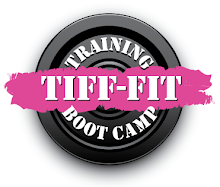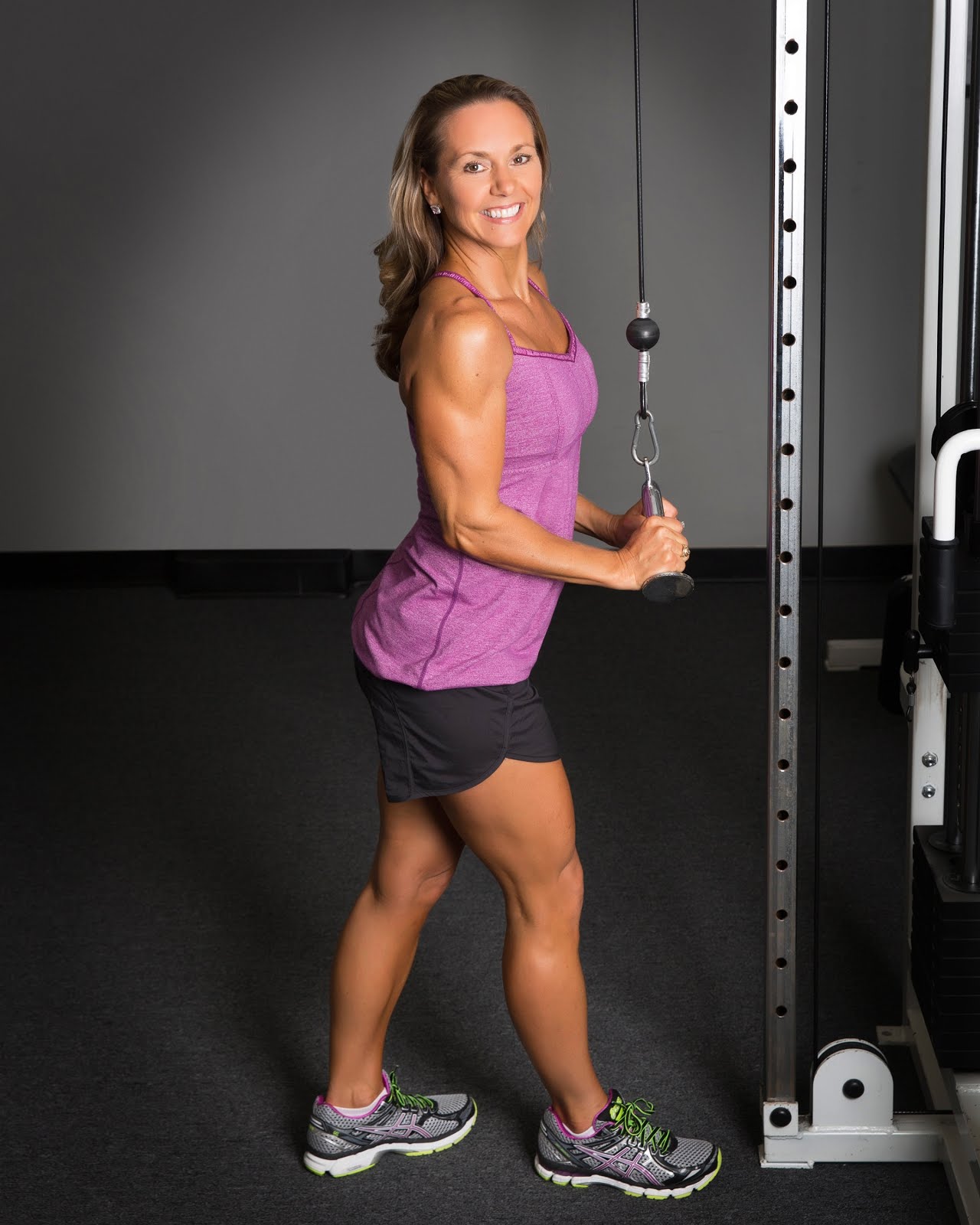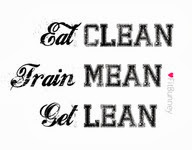Pro-Rated Boot Camp Session
Yay Burpees!
You know it, baby!
Tiff-Fit

That's how we roll!
Tuesday, January 25, 2011
Top 5 Resolution Mistakes
Monday, January 24, 2011
Stocking Up on Healthy Foods...
•Work fruits and vegetables into the daily routine, aiming for the goal of at least five servings a day. Be sure you serve fruit or vegetables at every meal.
•Make it easy for kids to choose healthy snacks by keeping fruits and vegetables on hand and ready to eat. Other good snacks include low-fat yogurt, peanut butter and celery, or whole-grain crackers and cheese.
•Serve lean meats and other good sources of protein, such as fish, eggs, beans, and nuts.
•Choose whole-grain breads and cereals so kids get more fiber.
•Limit fat intake by avoiding deep-fried foods and choosing healthier cooking methods, such as broiling, grilling, roasting, and steaming. Choose low-fat or nonfat dairy products.
•Limit fast food and low-nutrient snacks, such as chips and candy. But don't completely ban favorite snacks from your home. Instead, make them "once-in-a-while" foods, so kids don't feel deprived.
•Limit sugary drinks, such as soda and fruit-flavored drinks. Serve water and low-fat milk instead.
How to Be a Role Model
The best way for you to encourage healthy eating is to eat well yourself. Kids will follow the lead of the adults they see every day. By eating fruits and vegetables and not overindulging in the less nutritious stuff, you'll be sending the right message.
Another way to be a good role model is to serve appropriate portions and not overeat. Talk about your feelings of fullness, especially with younger children. You might say, "This is delicious, but I'm full, so I'm going to stop eating." Similarly, parents who are always dieting or complaining about their bodies may foster these same negative feelings in their kids. Try to keep a positive approach about food.
Don't Battle Over Food
It's easy for food to become a source of conflict. Well-intentioned parents might find themselves bargaining or bribing kids so they eat the healthy food in front of them. A better strategy is to give kids some control, but to also limit the kind of foods available at home.
Saturday, January 22, 2011
More Healthy Eating and Portion Control
TIPS TO REGAIN CONTROL
Don't let your portions control you. Control them with these tips:
Cook at home instead of eating out.
Avoid all-you-can-eat buffets.
Say no to upsizing.
Order an appetizer instead of an entrée.
Split meals or pack some away for later.
Order salad dressing on the side.
Don't eat snacks out of large boxes or bags.
Serve yourself a small amount on a plate and put away the rest.
Read labels. One large muffin, for example, may actually be equal to two servings.
Use a measuring cup to measure portions until you learn to eyeball proper serving sizes.
Order the small size or kid's size instead of a large.
Don't be fooled. Just because something is labeled "Gluten-free" or "No trans fat" doesn't mean you should eat unlimited quantities.
Use smaller plates, bowls and drinking glasses.
Fill half your plate with vegetables; split the other half between grains and lean meat or protein.
Friday, January 21, 2011
When it comes to food portions, size does matter

Forget about counting calories, cutting carbs or tracking points. To shrink your waistline, start by shrinking your portions.
"If you want to lose weight, you've got to eat less calories. It's very simple math, but people don't want to see it," says Lisa Young, a registered dietitian and author of The Portion Teller Plan.
"I don't care if the food has omega-3 in it, I don't care if it has vitamin D in it, I don't care if it has calcium in it. You've got to eat less of it."
Portion sizes have been growing exponentially in this country for decades, and we've grown with them.
According to the U.S. Department of Agriculture, the average hamburger in 1957 was just 1 ounce of cooked meat. By 1997, it was 6 ounces.
In that 40-year span, a "large" soda grew from 8 ounces to 32 ounces or more, and a medium box of popcorn at the movies swelled from 3 cups to 16 cups.
Between the early 1960s and 2005, the prevalence of obesity in U.S. adults increased from about 13 percent to about 35 percent, according to the Centers for Disease Control and Prevention.
"We go to restaurants, we get these very large portion sizes that are sometimes two or three times what we need," says Rayna Wooten, owner of Nutrition Therapy Associates in San Antonio. "That definitely distorts things and makes it more difficult translating things at home."
The next time you order fried chicken at a restaurant or dish spaghetti onto your plate at home, pause a moment and try to guess how many servings you're about to eat. If you're like many Americans, you'll underestimate nearly every time.
One reason we love big portions? We love value. We pride ourselves on getting a bargain — 64 ounces of soda for only $3 or a cheeseburger the size of a toddler's head for $5. Unfortunately, it's at the expense of our bodies.
If we ate and drank only what we were truly hungry and thirsty for, big bags of popcorn and jumbo burgers might not present such a problem.
But that's not how it works.
"We eat with our eyes, not with our stomachs," says Brian Wansink, author of Mindless Eating: Why We Eat More Than We Think.
Studies show that what we eat is influenced by everything from plate size (we eat more off bigger plates) to serving size (we eat more if we're given larger servings) to food visibility (we eat food when we see it, not always because we're hungry).
We also eat more when we don't see the whole amount we're consuming, such as when we dine or snack out of a package or a container.
If we were to see how much we were eating, we'd likely eat 15 percent or 20 percent less, Wansink says.
Often, we just don't know when to stop. In an experiment at the Cornell University Food and Brand Lab, Wansink found subjects consumed more tomato soup when a hidden tube kept filling their bowls as they ate.
The easiest way to eat less? Change our environment so it's harder to overeat, he says.
That means setting the table with smaller plates, using smaller serving spoons to dish out food and keeping candy dishes off our desk at work.
Deeper issues
Sometimes we overeat because we're hungry for something besides food.
People often eat past the point of fullness when they are using food as a distraction from problems - a way to cope with boredom, stress, grief or anxiety - or as a reward, says Samantha Rushing, a licensed professional counselor with Southwest Psychotherapy Associates in Houston.
Unresolved emotional trauma also can cause people to turn to food as a way to cope, says Rushing, who works with surgical and nonsurgical weight-loss patients. They use food to numb feelings of shame, guilt, inadequacy and powerlessness; as with any addiction or compulsion, food is a drug that offers escape.
People struggling with weight-loss issues may benefit from therapy to treat emotional eating.
"I say, 'The golden rule for eating is to treat yourself the way you want to feel,'" Rushing says. "People really pause with that because most of them have never felt their feelings. This is an invitation for the first time in their lives to sit with those feelings and understand that the feeling won't kill them."
Monday, January 17, 2011
Important News If You Eat Yogurt
Yogurt can be both delicious and healthy, but the problem is that most people are mistakenly buying yogurt that is TERRIBLE for their health and waistline, even though it’s touted as “healthy as can be”.
Take for example, this label from a popular “low fat” yogurt:

Sounds like a healthy option…”low fat yogurt”. But no. 33 grams of carbs, 27 grams of sugar (most of which is dreaded high fructose corn syrup), and only 5 grams of protein. That is, essentially, a recipe for fat storage despite the fact it’s “low fat”.
So, what type of yogurt should you be eating? Without a doubt the answer is plain Greek yogurt. Compared to the above, plain Greek yogurt has 6xs the protein and 1/3 as much sugar (which is simply the naturally occuring milk sugars lactose and galactose).
That’s 31 grams of protein per 8 oz and just 12 grams of low-glycemic carbs!
Need something a little sweeter than plain yogurt? Throw some mixed berries in (strawberries, raspberries, blackberries, blueberries, etc) and/or sweeten it a tad with some Splenda or Stevia. DELICIOUS.
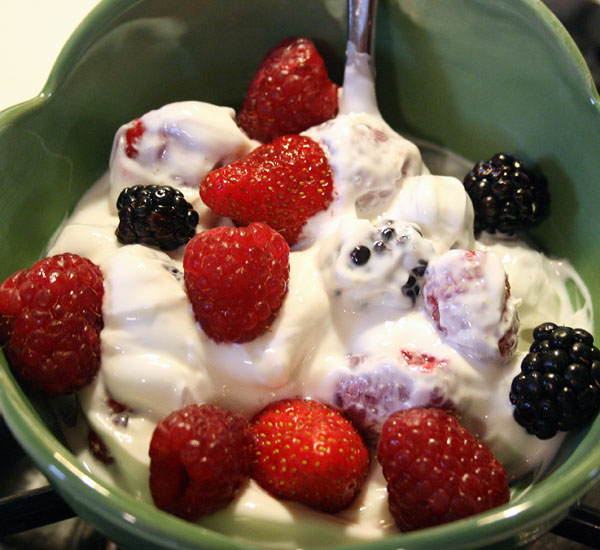
This is a great snack to have throughout the day, and it packs a ton of high quality nurtients in to a very filling meal.
Take home message: Ditch the sugar-laden “junk” yogurt and go with delicious, thick, plain Greek Yogurt instead (look for the 0% fat variety).
Monday, January 10, 2011
Exercise Intensity Levels

Measuring Intensity
There are several ways to measure exercise intensity.1 One common method measures the amount of oxygen consumed by the body as an activity is performed. This method is expressed in studies as the percentage of maximum oxygen consumption, or %-VO2 max. The oxygen consumption method is used most often in a research setting.
Another method of measurement works with the increased heart rate that occurs with exercise. The greater the intensity of the activity being performed, the higher the heart rate. This method is expressed as a percentage of maximum heart rate or %-MHR.
Measuring heart rate is the method most often used to evaluate intensity in everyday life or to set the level of exercise in physical training.
Low, moderate and high levels of exercise intensity, as measured by heart rate, are defined as follows:
Low (or Light) is about 40-54% MHR.
Moderate is 55-69% MHR.
High (or Vigorous) is equal to or greater than 70% MHR.
An individual's maximum heart rate can be estimated by using the formula: 220 – age in years = MHR. Pulse rate can then be monitored while an exercise is being done and the % MHR calculated to assess intensity.
So, for example, the estimated MHR for a 50-year-old individual would be 220 - 50, or 170. Let's say that an individual's heart rate measured 100 beats per minute performing a certain activity. Since 100 is approximately 59% of the MHR (170), that would be considered a moderate level of exercise. The overall levels of intensity for a 50-year-old would be as follows:
Low Intensity: heart rate is 68-to-92 beats per minute.
Moderate Intensity: heart rate is 93-to-118 beats per minute.
High Intensity: heart rate is more than 119 beats per minute.
Rating of Perceived Exertion
A simpler method than monitoring heart rate, which also corresponds with measured MHR, is the Rating of Perceived Exertion (or RPE). RPE is measured by having a person rate how they feel (psychological perception) when performing an activity. This kind of a survey, in which a person rates their perceptions, attitudes or feelings on a scale, is known as a Likert scale.
 Level of Intensity--- RPE--- Physical Cues
Level of Intensity--- RPE--- Physical CuesLight--- Easy ---Does not induce sweating unless it's a hot, humid day. There is no noticeable change in breathing patterns.
Moderate--- Somewhat hard--- Will break a sweat after performing the activity for about 10 minutes. Breathing becomes deeper and more frequent. You can carry on a conversation but not sing.
High--- Hard--- Will break a sweat after 3-5 minutes. Breathing is deep and rapid. You can only talk in short phrases.
All activity whether done at a light, moderate, or high level of intensity expends energy, and therefore is helpful for weight loss. The more intense the exercise and/or the longer the duration of exercise, the greater the energy expended per minute and the greater the impact on weight loss.
Friday, January 7, 2011
The Truth About Eggs
Are Whole Eggs or Egg Whites Better for You?
by Mike Geary, Certified Nutrition Specialist, Certified Personal Trainer
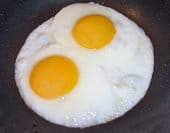 I was on a weekend trip with some friends recently and one of my friends was cooking breakfast for the whole group. I went over to see what he was cooking and saw he was getting ready to make a big batch of eggs.
I was on a weekend trip with some friends recently and one of my friends was cooking breakfast for the whole group. I went over to see what he was cooking and saw he was getting ready to make a big batch of eggs.
Well, to my shock and horror, I noticed that he was cracking the eggs open and screening the egg whites into a bowl and throwing out the egg yolks. I asked him why the heck he was throwing out the egg yolks, and he replied something like this...
"because I thought the egg yolks were terrible for you...that's where all the nasty fat and cholesterol is".
And I replied, "you mean that's where all of the nutrition is!"
This is a perfect example of how confused most people are about nutrition. In a world full of misinformation about nutrition, somehow most people now mistakenly think that the egg yolk is the worst part of the egg, when in fact, the YOLK IS THE HEALTHIEST PART OF THE EGG!
By throwing out the yolk and only eating egg whites, you're essentially throwing out the most nutrient dense, antioxidant-rich, vitamin and mineral loaded portion of the egg. The yolks contain so many B-vitamins, trace minerals, vitamin A, folate, choline, lutein, and other powerful nutrients... it's not even worth trying to list them all.
In fact, the egg whites are almost devoid of nutrition compared to the yolks.
Even the protein in egg whites isn't as powerful without the yolks to balance out the amino acid profile and make the protein more bio-available. Not to even mention that the egg yolks from free range chickens are loaded with healthy omega-3 fatty acids.
Yolks contain more than 90% of the calcium, iron, phosphorus, zinc, thiamin, B6, folate, and B12, and panthothenic acid of the egg. In addition, the yolks contain ALL of the fat soluble vitamins A, D, E, and K in the egg, as well as ALL of the essential fatty acids (EFAs).
And now the common objection I get all the time when I say that the yolks are the most nutritious part of the egg...
"But I heard that whole eggs will skyrocket my cholesterol through the roof"
No, this is FALSE!
First of all, when you eat a food that contains a high amount of dietary cholesterol such as eggs, your body down-regulates it's internal production of cholesterol to balance things out.
On the other hand, if you don't eat enough cholesterol, your body simply produces more since cholesterol has dozens of important vital functions in the body.
 And here's where it gets even more interesting...
And here's where it gets even more interesting...
There have been plenty of studies lately that indicate that eating whole eggs actually raises your good HDL cholesterol to a higher degree than LDL cholesterol, thereby improving your overall cholesterol ratio and blood chemistry.
And 3rd... high cholesterol is NOT a disease! Heart disease is a disease...but high cholesterol is NOT. Cholesterol is actually a VERY important substance in your body and has vitally important functions... it is DEAD WRONG to try to "lower your cholesterol" just because of pharmaceutical companies propaganda that everyone on the planet should be on statin drugs.
In addition, the yolks contain the antioxidant lutein as well as other antioxidants which can help protect you from inflammation within your body (the REAL culprit in heart disease, not dietary cholesterol!), giving yet another reason why the yolks are actually GOOD for you, and not detrimental.
To help bring even more proof that whole eggs are better for you than egg whites, I recently read a University of Connecticut study that showed that a group of men in the study that ate 3 eggs per day for 12 weeks while on a reduced carb, higher fat diet increased their HDL good cholesterol by 20%, while their LDL bad cholesterol stayed the same during the study. However, the group that ate egg substitutes (egg whites) saw no change in either and did not see the improvement in good cholesterol (remember that higher HDL levels are associated with lower risk of heart disease) that the whole egg eaters did.
So I hope we've established that whole eggs are not some evil food that will wreck your body... instead whole eggs are FAR superior to egg whites.
But what about the extra calories in the yolks?
This is actually a non-issue and here's why... even though egg yolks contain more calories than just eating the egg whites, the yolks have such a high micro-nutrient density in those calories, that it increases your overall nutrient density per calorie you consume. Essentially, what this does is help to regulate your appetite for the remainder of the day, so you end up eating less calories overall. In addition, the healthy fats in the egg yolks help to maintain a good level of fat-burning hormones in your body.
Overall, this means that the extra fats (healthy fats) and calories from the yolk are so nutrient-dense that they actually HELP you to burn off body fat!
Also, your normal supermarket eggs coming from mass factory farming just don't compare nutritionally with organic free range eggs from healthy chickens that are allowed to roam freely and eat a more natural diet. Your typical cheap grocery store eggs will have lower nutrient levels and a higher omega-6 level and lower omega-3 level. On the other hand, the cage-free organic eggs from healthier chickens allowed to eat more natural feed and roam freely will have much higher vitamin and mineral levels and a more balanced healthier omega-3 to omega-6 fatty acid ratio.
I recently compared eggs I bought at the grocery store with a batch of eggs I got at a farm stand where the chickens were free roaming and healthy.
Most people don't realize that there's a major difference because they've never bought real eggs from healthy chickens... The eggs from the grocery store had pale yellow yolks and thin weak shells. On the other hand, the healthier free range eggs from the local farm had strong thick shells and deep orange colored yolks indicating much higher nutrition levels and carotenoids... and just a healthier egg in general.
This is due to the fact that a free-roaming hen allowed to roam on plenty of land will eat a variety of greens, insects, worms, etc transferring MUCH higher levels of nutrients to the eggs compared to an unhealthy hen that is trapped inside a dark factory farm hen house in horrible conditions and fed nothing but piles of corn and soy. It's a DRASTIC difference in the nutrition that you get from the egg.
So next time a health or fitness professional tells you that egg whites are superior (because of their "fat-phobic" mentality towards dietary fats), you can quietly ignore their advice knowing that you now understand the REAL deal about egg yolks.
And can we all please STOP with this sillyness about eating an omelete with 4-5 egg whites and only 1 egg yolk... If you want real taste and real health benefits, we'd all be better off eating ALL of our eggs with the yolks.
After all, do you REALLY think that our ancestors thousands of years ago threw out the yolks and only ate the egg whites? NOT A CHANCE! They intuitively knew that all of the nutrition was found in the yolks. But our modern society has been brainwashed with misinformation about fats and cholesterol.
Another interesting study about eggs...
I read a study recently that compared groups of people that ate egg breakfasts vs groups of people that ate cereal or bagel-based breakfasts. The results of the study showed that the egg eaters lost or maintained a healthier bodyweight, while the cereal/bagel eaters gained weight.
It was hypothesized that the egg eaters actually ate less calories during the remainder of the day because their appetite was more satisfied compared to the cereal/bagel eaters who would have been more prone to wild blood sugar swings and food cravings.
Oh, one last thing I almost forgot... I personally eat 4 whole eggs almost every day with breakfast, and I maintain single-digit bodyfat most of the year.
Enjoy your eggs and get a leaner body!

